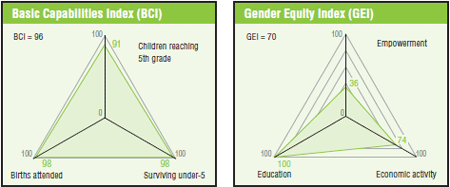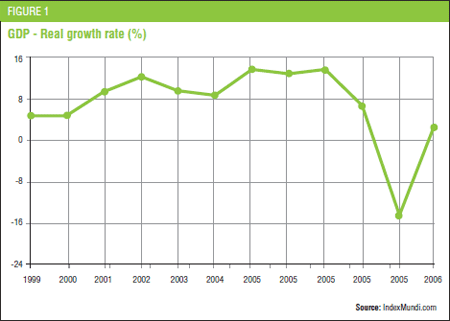SOCIAL WATCH
Center for the Development of Civil Society, CDCS Armenia
Dr. Svetlana Aslanyan
Despite recent economic growth, Armenia continues to confront economic, social and environmental challenges. The Government launched a Sustainable Development programme, but at the same time made substantial investments in mining and other extractive industries. The Teghut copper-molybdenum mining project in particular poses a threat both to the environment and to sustainable development. The Government has also failed to address pollution, deforestation, soil degradation, and other environmental issues, making the effective implementation and enforcement of environmental laws, as well as increased transparency and public participation in policy-making essential.
 |
Armenia’s “Sustainable Development Programme (SDP) for 2009-2012,"[1]adopted in 2008, includes a series of measures designed to reduce poverty through: a) stimulation of economic growth and improvement of the business environment; b) increased employment and promotion of medium and small business; c) greater public access to infrastructure services; d) enhanced social assistance programs for the poor; e) expanded access to and consumption of culture; f) more extensive social assistance programs for youth; g) a reduction in corruption within State Government, the health and education systems, the judiciary system and local government.
Implementation of the SDP was set back by the impact of the 2008-09 global economic crisis. Reduced investment in construction hurt small and medium-sized businesses, and the proportion of the population living below the poverty line jumped from 27% to 47%. While per capita GDP had soared from USD 3,576 to USD 11,916 from 2004 to 2008[2] the impact of the economic crisis was negative (see chart), particularly for sustainable development. Although economic growth resumed in 2009 and 2010,[3] in most cases this has helped realize only short-term economic objectives. Policies set up for the environmental and social spheres have been neglected,[4] and the Government has decided to pursue sustainable development only in selected areas.
Environmental issues
 |
One of the country’s most pressing environmental concerns is limited access to clean water.[5] In many cases, aging and corroded infrastructure allows sewage to seep into freshwater pipes. Yerevan, the capital, still lacks a fully functional wastewater treatment plant. In the northern part of the country, rivers such as the Debed have alarming concentrations of lead, while in places such as the Ararat Valley, most water pollution comes from pesticides containing pollutants such as arsenic and cadmium.[6] Experts predict that the most likely climate change scenario will cause severe drinking water shortages in the coming decades.[7]
Air pollution is also increasing at an alarming rate. Yerevan, for example, is located in a geological depression in which stagnant air exacerbates heavy pollution, 90% of which is caused by vehicles.[8] The other 10% is highly toxic, containing smoke filled with the residue of plastics burned at industrial and mining facilities near the city. The atmosphere in other cities is also heavily polluted. Alaverdi, for example, has had 11.4 times the permitted level of sulfur dioxide in recent years.[9] Between 2001 and 2005, recorded cases of respiratory disease jumped 45%; experts believe the real incidence of diseases such as asthma is actually far higher.[10]
Air pollution is exacerbated by the common practice of burning waste in the open. Unauthorized burning releases dioxins, furans and other toxic chemicals that can cause a wide range of health problems, including skin disorders, liver problems, immune system impairment and certain types of cancers.[11]
Deforestation, which has escalated to an unprecedented level, is another concern. Only 7% of the territory remains forested, down from 35% two centuries ago, and much of this is degraded. The leading causes include use of wood for fuel, due to a lack of alternatives, and the Government’s decision to allow mining in ecologically sensitive areas, which shows the lack of official recognition of the importance of natural forests.[12]
Corruption and the environment
Many environmental problems in Armenia are closely linked to corruption, especially in forestry and mining. For example, environmental restrictions are not enforced in most mining operations; in the period from 2001 to 2007, the then-Minister of Nature Protection issued several mining licenses to relatives.
It is widely believed that cases of corruption related to businesses sponsored by high level Government officials are abundant.[13] Certainly Government actions have not been able to stop the destruction and degradation of the forests due to illegal logging. Also, many forest areas have been improperly reclassified and allocated to private individuals. In 2007, for example, the Government changed the status of the central part of the Khosrov Reserve to allow private construction and agricultural activities; it made this decision without consulting experts in the field.
The Teghut mountains: a case study in unsustainable exploitation
The Government is pursuing an extraction-led development model, as evidenced by its willingness to allow massive investment in mining. The Armenian Copper Program (ACP), for example, has been granted a 24-year license to extract copper and molybdenum ore from the Teghut Mountains. ACP is developing an open-pit mine with a surface area of 240 ha, all of which is forested land.[14]
The village of Teghut, located in the Lori Region in the northeast has 3,600 residents, many of whom rely on subsistence agriculture. The surrounding forest is home to many rare and endangered plants and animals; species found there include 260 insects, 86 birds, 55 mammals and 10 reptiles.[15]
ACP has already built numerous forest access roads for exploratory drilling sites, indiscriminately ravaging several areas. Ultimately, according to ACP, the project will require 670 ha, of which 510 ha are currently forested. [16]
ACP has declared that it will compensate for the damage by planting trees in Yerevan, but this plan is inadequate and unrealistic. New trees cannot replace established forest habitats; mature trees may not survive a move.
The mining operations will produce waste rock and tailings, which may contain silver, gold, rhenium, lead, arsenic, copper, molybdenum, zinc and sulfurous chemicals. In the inefficient extraction process that will be used, valuable metals such as renium will be lost; much worse, it will leave tailings that will pollute both local water and the air. If leakage occurs, toxic chemicals could get into the nearby Kharatanots River, already polluted by the copper tailing dump in the village of Aghtala, and where numerous downstream communities get their drinking water.
The deleterious environmental impact of the mine will hardly be offset by economic benefits. The project’s economists estimate that it contains ore worth more than 20 billion USD, of which the country will receive only 1.2-1.7% in taxes and fees and suffer severe, long term environmental problems costing USD 6.5 million. So far, there is no independent economic analysis of the potential environmental damage.[17]
As currently planned, construction of the ore processing plant and exploitation of the copper-molybdenum mine will breach 77 laws, as well as a range of international conventions signed and ratified by the Republic of Armenia, including the UN Framework Convention on Climate Change, the UN Convention on Biodiversity, the UN Convention on Combating Desertification and the European Landscape Convention. However, the Government has designated the Teghut mining operation a high priority for its contribution to “economic development,” reflecting its short-term perspective, as well as its corrupt practices. It also reveals its lack of expertise, respect for the law, care for the environment and interest in pursuing a long-term sustainable development model.
Conclusions
The rapid growth of some sectors of the economy, along with the lack of appropriate government management, have created serious environmental problems and challenges. To promote sustainability, the country must make environmental protection a priority.
Armenia has ratified many international conventions on issues such as biodiversity, climate change and desertification. These commitments, as well as the voice of civil society, have been largely ignored. Improving environmental governance will require effective implementation and enforcement of existing environmental laws, as well as greater transparency and public participation in policy-making. This, in turn, will require a concerted effort to increase popular awareness of environmental issues.
[2] Index Mundi, Armenia GDP real growth rate (%), (2010), <www.indexmundi.com/g/g.aspx?c=am&v=66>.
[3] Ibid.
[4] Edita Vardgesyan, The exploitation of the Teghut Copper-Molybdenum Mining (Republic of Armenia) and the Concept of Sustainable Development, (2009),<www.cerdi.org/uploads/sfCmsContent/html/323/Vardgesyan.pdf>
[5] Policy Forum Armenia, The state of Armenia’s environment, (2010), <www.pf-armenia.org/fileadmin/pfa_uploads/PFA_Environmental_Report.pdf>.
[6] Ibid.
[7] Ibid.
[8] This Month in Armenia, Car emissions causing more respiratory problems in Yerevan, (July 2009), <thismonth.wordpress.com..
[9] Policy Forum Armenia, The state of Armenia’s environment, (2010), op cit.
[10] Marianna Grigoryan, “Armenia: Environmental Change Spurs Respiratory Diseases,” (19 October 2006), <www.eurasianet.org/departments/environment/articles/eav102006.shtml>.
[11] Ibid.
[12] Ibid
[13] See: <en.wikipedia.org/wiki/Corruption_in_Armenia> and <www.armeniatree.org/environews/enews_hakobyan070707.htm>.
[14] Policy Forum Armenia, The state of Armenia’s environment, (2010), op cit.
[15] Ibid.
[16] See: <www.foe.org/pdf/Teghut_Fact_Sheet.pdf> and < news.mongabay.com/2008/0129-hance_armenia.html>
[17] Ibid.
